June 2011 Newsletter
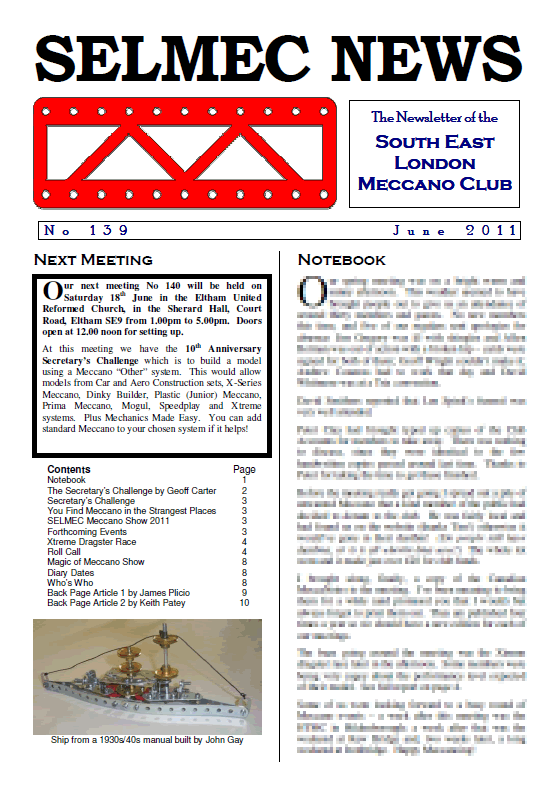
June 2011 Newsletter
Issue 139
This was one of our informal quarterly meetings where our members showed off their latest Meccano creations.
At around 2:00pm we had a short committee meeting, followed by the Model Tour in which members were invited to give a short talk about their models — in particular their entries for the Secretary’s Challenge!
Xtreme Dragster Races
At this meeting we held two Xtreme dragster races. The Xtreme kit includes a pull-back ‘motor’ and it’s the motor that members had to incorporate into their model.
Although the kit as bought is a dragster, using a no-nuts system for joining the parts together, members didn’t have to use the parts from the kit in their dragster – just the motor and other parts from standard Meccano or the Xtreme dragster to complete it.
Watch our video of the races
Written by Geoff Carter
The Result of Several Minutes Thought
Yes, after careful planning, I came up with the idea of the Secretary’s Challenge! It was at the January 2001 meeting. We had discussed, at some length, Meccano’s Official Centenary (surely it should have been in 2008?) and the club’s 25th anniversary, and whether we, the club, should celebrate these events (five years before, for the 20th anniversary, we had a party that both I and my wife had enjoyed). This time, however, it was decided not to have any celebration.

Geoff Carter’s Steel Tec Millennium Falcon for the Film and TV Secretary’s Challenge
The meeting continued, the Chairman was talking and my thoughts wandered — what if the members all brought in a model, made from nickel Meccano? Or, at least, a model from the nickel era? Not practical, not all members had a manual from the nickel era. But they could build a model from their oldest manual — this should give a display of models covering Meccano’s 100 years. The naughty part of me said “We can avoid a general discussion on the idea by making it personal — call it ‘The Secretary’s Challenge’!”
It was my turn to speak. I made my usual handful of announcements and, trying to make it sound carefully planned (not something I was still working out), I waffled a bit about the centenary and a challenge by the Secretary and then I said “Get out your oldest manual and build a model from it, as close as possible to the original”. I wanted to ask for the models to be brought to the next meeting, but I realised that members not present wouldn’t know about the Challenge until they got the Newsletter, a week or two before the meeting, and so wouldn’t have enough time to build a model. So I made it for the June meeting.
On the way home, I thought that the Challenge was a good idea and, though my original plan was for it to be a ‘one-off’, I liked the idea of a ‘Magic’ motor-powered model for the next Challenge! Luckily, the members seemed to like the idea and the Challenges continued.
One Challenge, that I thought was the worst idea ever, turned out to be one of the best supported! I was looking at a narrow 1” x ½” obtuse angle bracket and I thought that, if you joined them end-to-end, you would have an interestingly-shaped ‘ring’ and my idea for the Challenge was to make a piece by bolting similar pieces end-to-end and then building the resulting shape into a model. But I didn’t know how to word the Challenge without mentioning ‘circle’ or ‘ring’!
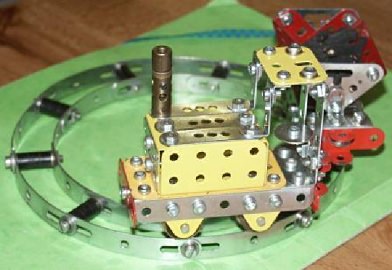
Chris Warrell’s Miniature Railway, as it appeared for the Rings and Circles Secretary’s Challenge
I turned up at the target meeting expecting to have to apologise for such a poor challenge, only to find that it was one of the best supported challenges of all! Unfortunately, every model was built on a circle! One model from this Challenge — Chris Warrell’s circular railway, was developed into a model that was published in Constructor Quarterly issue 84, June 2009. Maybe this Challenge could be re-visited, with a ban starting with a circle?
Another of these early Challenges — for a model built from a list of parts that I put together — was 'borrowed' by the MWT Club, in Wanganui, New Zealand for their challenge and SELMEC got a mention in the NZFMM Magazine!
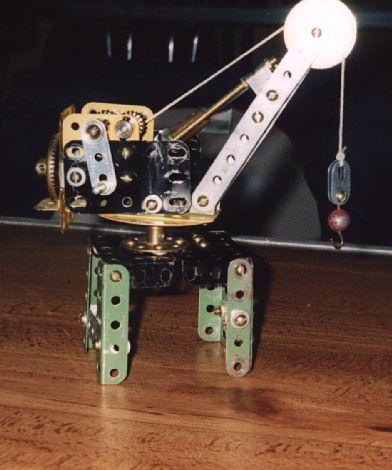
Crane for the Set Parts List Secretary’s Challenge by Andrew Couzens
It soon became difficult to keep thinking of Challenges and I invited members to make suggestions, but the only member to do so was Peter Clay. He was looking for a reason to make an adjustable stand for a metronome, so his idea was to build something with a practical use. This was another successful challenge — I remember Ivor Ellard said that he went round his house before leaving for the Club, collecting things he had made; these included a scraper for his fish tank and a jig for building plastic model aeroplane wings.
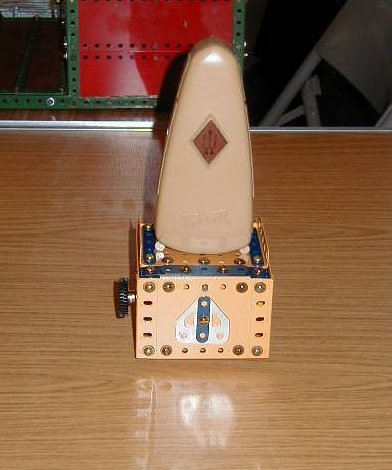
Metronome on an adjustable stand by Peter Clay
When I stood down as Secretary, Chris Warrell asked the members whether he should continue the Challenge — the vote appeared unanimous. He did, however, change the timing, so that the Challenge models were brought to the next meeting, as I had originally wanted.
After all this time, it is a good feeling to see that The Secretary’s Challenge is continuing, virtually un-altered from my carefully planned concept!
You can discover our future Challenges by viewing the upcoming meetings on our events page.
Written by Chris Warrell
At our April 2011 meeting we held the Xtreme Dragster Races. And very thrilling they were too! It had been decided to run two races — one for dragsters that looked like a dragster, with or without a driver; and the other race for minimalist creations which would be lightweight and fast.
Watch our video of the races
The only criteria was that the dragster had to incorporate the pull-back ‘motor’ that comes in the Xtreme Dragster kit. It didn’t matter what other Meccano went into your model. The race was dreamt up by Chris Fry and Ralph Laughton.
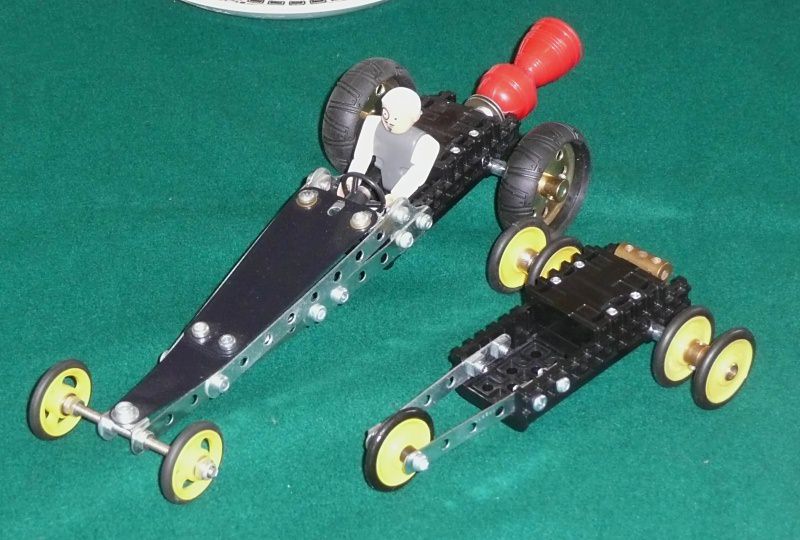
Chris’s dragster
There were five entries in the first race — the dragster look-alike one — and they were from Brian Elvidge, Ralph Laughton, Douglas Windibank, Chris Fry and Peter Clay. These five competed in two heats to get three machines into the final. Like previous races, a number of vehicles veered off in various directions, sending spectators running or leaping out of the way. Doug, Ralph and Chris made it to the final with Chris Fry being the winner.
There were six entries for the three heats in the minimalist race. We had entries from Doug, Brian, Chris Warrell, Ralph, Chris Fry and Alan Wenbourne. They were considerably faster than the heavier dragsters in the first race. Taking a tip from Ralph, Alan won the final, against Chris Warrell and Douglas, with a machine that consisted of not much more than just the motor with wheels attached.
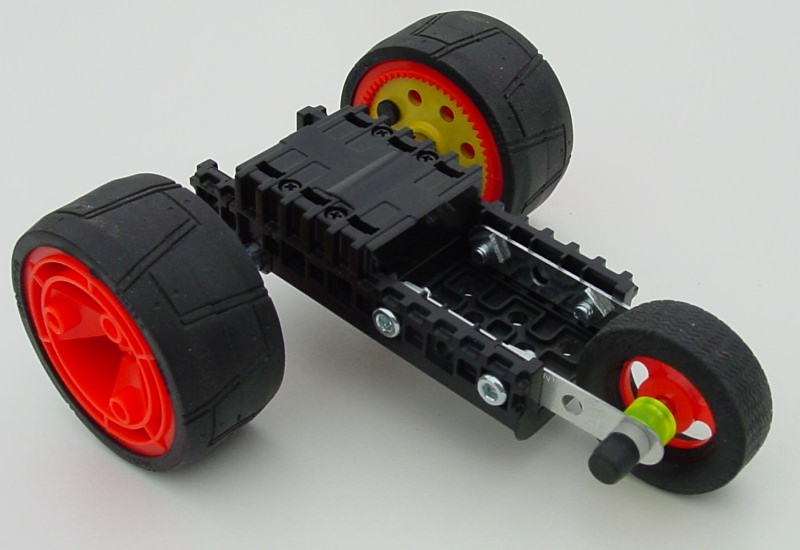
Alan’s dragster
Prizes (small second-hand Meccano sets) were awarded to the two winners by Frank Paine.
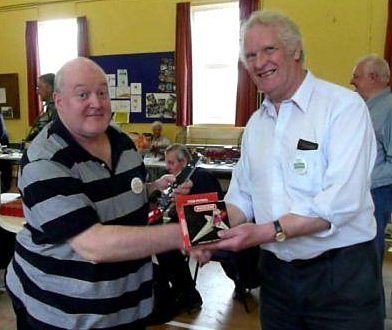
Chris Fry and Frank Paine
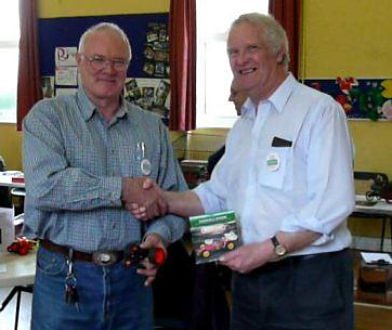
Alan Wenbourne and Frank Paine
Written by Santiago Plicio
Just after completing the building of my first new model of 2011, a Fairground Wheel I named The Disc-Comforter, I was instantly motivated by the idea of a new model. I decided to start constructing it despite not knowing whether I would have sufficient parts as much of my Meccano resources were still currently tied up in two of my other models, The Devil’s Whip and The Disc-Comforter. In addition to this I still have a robot model and for the first time in as long as I can remember, I have not started to dismantle previous models before starting the creative process on a new idea.
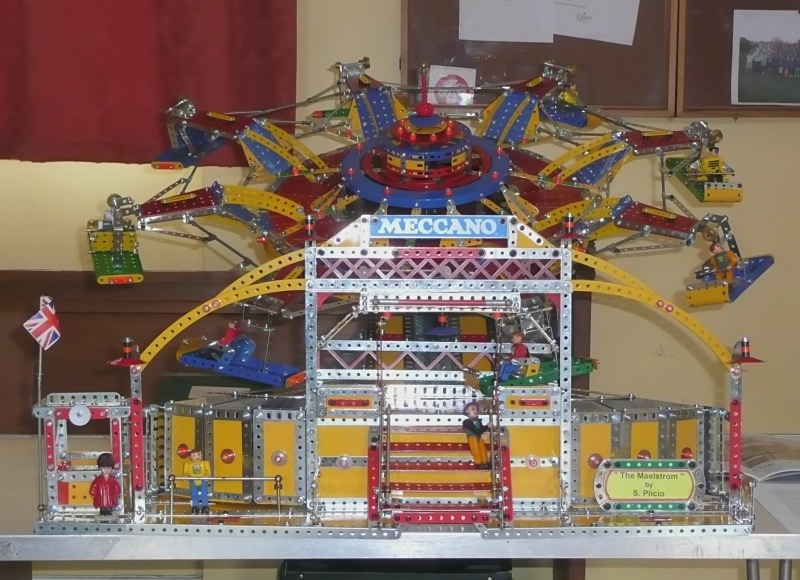
The front of the Maelstrom
Perhaps the availability of the rotating canopy from my largest ever model The Storm Rider was partly the reason for this, as I had kept it intact despite dismantling the rest of that model in January. I was always drawn to the idea of modifying it and using it again as part of a future model and I decided to use it, building the rest of the model around it. I had to change all the arms supports and fittings to produce the moving core where new carriages were to be fixed.
Having to be economical with parts resulted in the challenge to make a model that was strong and sturdy but equally lightweight and I believe it helped produce a more refined, sleeker design.
A long tubular arm in a tilting angle was built and fixed to the light supporting structure. At the top end a heavy-duty axle was well supported to hold the much heavier rotating unit with eight arms supporting the eight passenger carriages. A large toothed gear engaged by a small pinion was finally employed to drive the model, but not before several other inadequate systems were tried and discarded after failing to produce the smooth, steady and fast movement to the speed of rotation to the ride.
Due to the ride height of the carriages and where they come to rest at their lowest point, I had to construct the front of this fairground ride to an exact height with the only access by some steps at the immediate front.
A curved decking at both ends of the front added to the model’s sleek and modern design resulting with a pleasing aesthetic quality I had not initially expected to achieve. Decorative finishing touches were added including lights and a ticket kiosk.
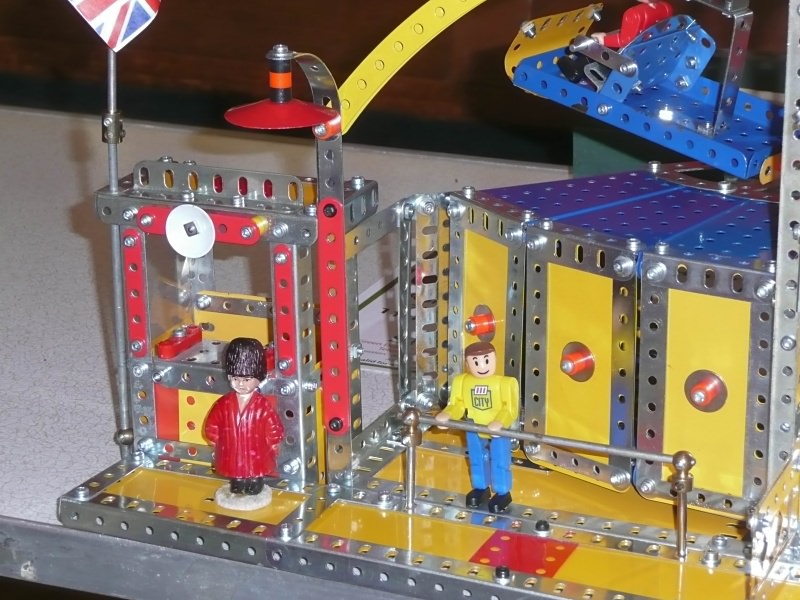
The ticket kiosk
The lightweight model can be easily transported by removing the rotating unit and cars from its main body.
The speeds that this model can reach are extremely fast and consequently it subjects the ride’s passengers to the effects of a thrilling G-force experience. Thrill seekers are thrown into a dry experience of perhaps what it might feel like to be caught in a huge whirlpool in a body of water, and from this idea the name was born.
The Maelstrom: Simple, slight, but a devastating force of nature nevertheless.
Report written by Keith Patey
The Telford and Ironbridge Meccano Society (TIMS) is a friendly club open to individuals of any age and ability (but children must be accompanied by an adult). Three meetings each year are held in February, August and November with the ‘Meccanuity’ Exhibition taking place on the first May Bank Holiday weekend. Further details can be obtained from their website.
The 2011 Exhibition was held from 30th April to 2nd May in the Enginuity complex at Coalbrookdale, Ironbridge Gorge, Shropshire. This site is open to the public and houses many interesting ‘hands-on’ exhibits. Adequate space was allocated to the Meccano wallahs and their models which included the usual suspects of Meccanographs, clocks, steam engines, cars, lorries, motor bikes, cranes, buses, helicopters, etc. and an extensive Hornby ‘O’ gauge layout. This year’s theme of fairground models was represented in abundance with many freelance machines on show.
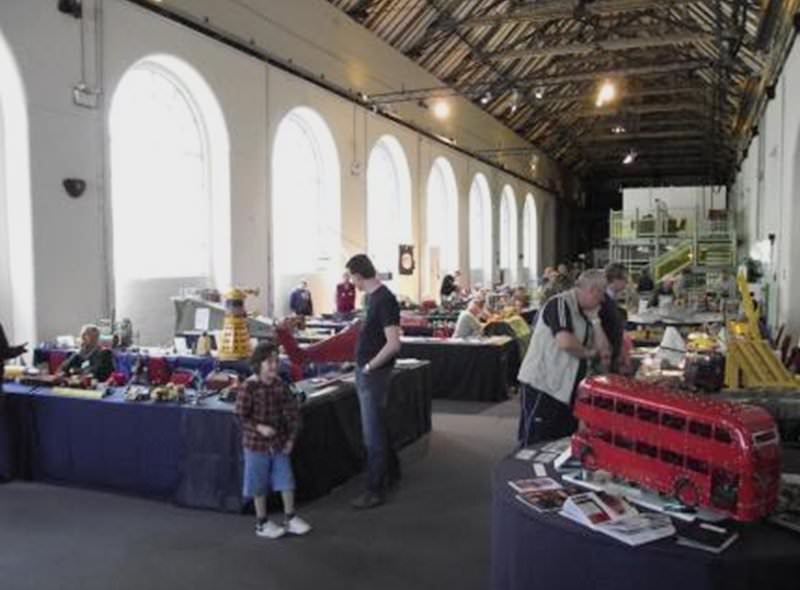
The main hall at the Meccanuity exhibition
The contingent from SELMEC was represented by the following members whose models have been reported previously but are hereby briefly acknowledged:
Ivor Ellard had his tongue-in-cheek version of the solution to the energy crisis, Kew Bridge Steam Museum building (with boilers) and a large Meccanograph.
Keith Patey brought a Bottom Dump Truck (from leaflet № 10.18) but not motorised.
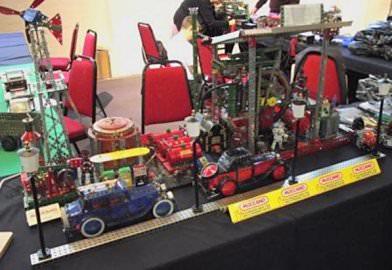
Ivor Ellard’s models
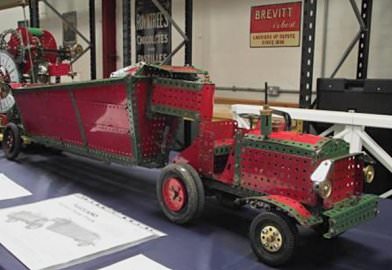
Keith Patey’s dump truck
Ralph and Sue Laughton brought a Nano roundabout and miniature Ferris wheel in pristine red/zinc, a race game featuring three quad-bike racers and a replica dealer’s Ferris wheel.
Jim MacCulloch had an impressive 100 ton dockyard crane, small beam engine, marching marauder (with six legs) and several small-scale models.
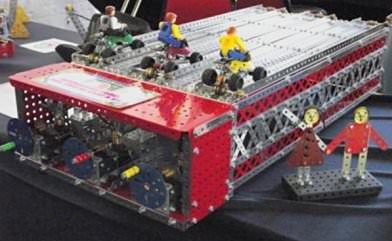
Ralph and Sue Laughton’s race game
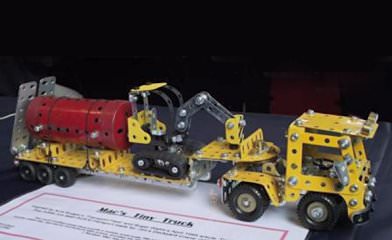
One of Jim MacCulloch’s models
Chris and Cathy Warrell showed the Royal Victoria Dock Bridge (1998) sited in London Docklands (switch-operated), a battle-fleet consisting of a submarine, river gunboat and battle cruiser (from sets 3 and 4), dragster, three-wheel sports car, drum kit, art deco table and chairs, Van Gogh’s chair and a Stetson-type hat with sundry Meccano adornments.
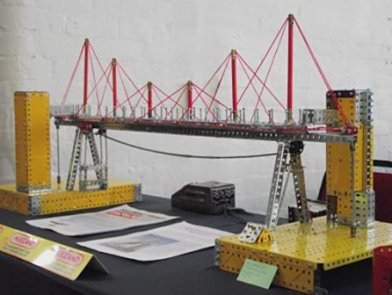
Chris Warrell’s bridge
Dave and Marilyn Taylor attended with their comprehensive array of parts/literature for sale, both new and used, some at ‘bargain prices’!
I think it fair that a good time was had by all and I take this opportunity to thank the organisers for all the hard work and effort entailed in running a successful exhibition. We were certainly made to feel welcome!
The Ping Pong Firing Range Challenge
In this very entertaining contest as many ping pong balls as possible had to be fired at a target in one minute. Of the five entries only two actually scored any points at all! And some fell far short. The winning machine (based on a tennis ball machine) was built by Rob Mitchell.
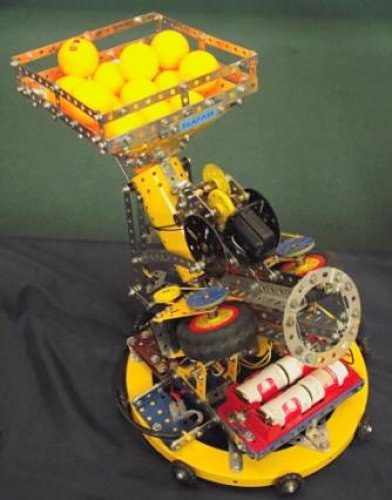
The winning machine built by Rob Mitchell